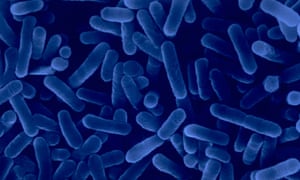 |
| Legionella pnuemophila (Image source: theguardian.com) |
Legionella pnuemophila pictured here, is a bacteria that can cause humans to develop acute pneumonia (also known as Legionnaire's disease or legionella pneumonia) 2-10 days after an individual breathes in a mist of water containing the bacteria. In other words, when aeorosolized, the inhaled bacteria can cause pneumonia. Although pneumonia can oftentimes be easily treated at home with the disease ending after 2-3 weeks substantial complications can arise from individuals that have immune deficiencies such as the elderly. Complications may also arise in individuals with diseases that affect the immune system such as: cancer patients undergoing chemotherapy, people infected with AIDS among others.
Presence of Legionella pnuemophila in water sources can pose health threats for high traffic areas, especially when there are numerous individuals in close contact with each other. A college campus may be a perfect breeding ground for the propagation of Legionella pnuemophila and ultimately pneumonia in a given population. For this reason knowing whether or not Legionella pnuemophila is present in the water and in biofilm around campus can help a campus implement ways to reduce the number of individuals that come into contact with this bacteria.
Knowing Legionella pnuemophila presence is the basis for the research that my team has been conducted in the past year and a half and at some point this research may help reduce the bacteria's population on campus or even eliminate it thus eliminating the potential for students, staff and faculty to develop pneumonia.
Hey David! It is very interesting to know what this bacteria can do. It also seems like a very interesting topic considering that we are college students. Imagine if we could take our research and be able to solve the problem would be amazing! There could be precautions and less sick people so they can keep on going to school. I’m excited to see how far this research takes us.
ReplyDelete